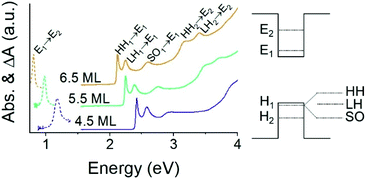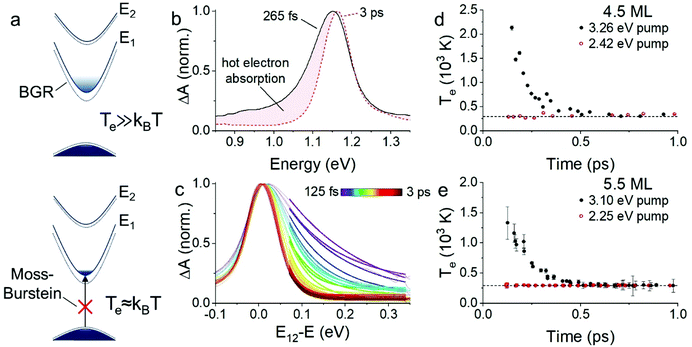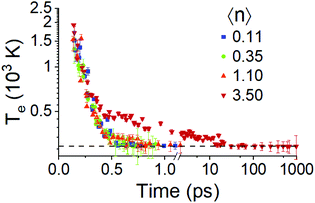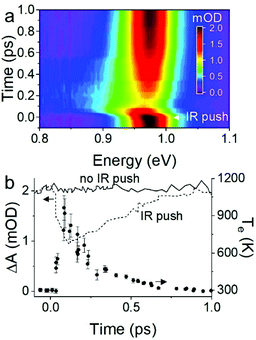Transient reshaping of intraband transitions by hot electrons†‡
Benjamin T.
Diroll
 *a and
Tathagata
Banerjee
*a and
Tathagata
Banerjee
 ab
ab
aCenter for Nanoscale Materials, Argonne National Laboratory, USA. E-mail: bdiroll@anl.gov
bDepartment of Physics, University of Illinois Urbana-Champaign, USA
First published on 11th January 2022
Abstract
Hot electrons, far above the lattice temperature of a material, present opportunities for enhanced solar energy harvesting or performance of otherwise unfavorable chemistry. The spectroscopic signatures and dynamics of hot carrier absorption and emission have been extensively studied in bulk and nanoscopic semiconductors, but the effects on intraband transitions are largely unexplored. Here, the effect of hot electrons on the properties of colloidal quantum wells made of cadmium selenide is examined using ultrafast spectroscopy. Similar to expitaxial quantum wells, these atomically precise materials support intersubband transitions (a class of intraband transitions in 1D and 2D materials) in the near-infrared spectral window. Using energy-dependent photoexcitation, it is shown that electrons reach effective temperatures of 2000 K or greater. This results in a substantial transient shift in the oscillator strength of the instersubband transition to lower energies on a sub-picosecond time-scale. Similar heating of electrons is achieved under mid-infrared re-excitation, which permits ultrafast transmittance modulation throughout the near-infrared.
Introduction
Hot carriers, which may have non-thermal energy distributions or effective temperatures above that of the material lattice, are important for many optoelectronic devices.1 They have been used in Gunn diodes for 60 years and more recent work has focused on the enhancing photovoltaic efficiency by exploiting the extra potential energy above the band gap2,3 or in photochemical reactions, where hot carriers lift contraints of band edge energies.4–6 The primary tool for studying hot carriers, due to their short lifetime, is time-resolved spectroscopy: many works have demonstrated the transient changes in band gap absorption or emission arising from hot carriers in semiconductors and metals.7–11 Yet there are few demonstrations of hot carrier effects on intraband transitions.12–14This work studies the effects of hot electrons on intraband transitions using cadmium selenide colloidal quantum wells (CQWs), which exhibit a class of intraband transitions, termed intersubband transitions, from the first to second conduction bands occuring in the near-infrared. Because intersubband transitions are the critical element of quantum cascade lasers15 and quantum well infrared photodetectors,16 the effects of hot electrons on these intraband transitions can alter gain spectra, thresholds, or current levels.17
Using variable pump energy ultrafast pump–probe spectroscopy, we find the dominant spectroscopic signature of hot electrons in CdSe CQWs is a sub-picosecond broadening and redshift of the intersubband transition, which is quantitatively approximated with a Boltzman distribution for electron temperature. With pump energies in excess of the band gap, hot electrons in the CQWs may reach effective temperatures higher than 2000 K, before cooling back to ambient temperature in less than 1 ps. Additionally, it is shown that photoexcitation of electrons already in the conduction band generates a similar spectral response to high energy photoexcitation, yielding sub-picosecond modulation at near-infrared wavelengths.
Results and discussion
Cadmium selenide CQWs are sheets consisting, in this case, of 4, 5, or 6 layers of cadmium selenide with an additional capping layer of cadmium atoms, to form 4.5, 5.5, or 6.5 monolayer (ML) structures. The electronic structure of the CQWs is shown alongside the absorption of the samples in Fig. 1. Quantum confinement in the thin axis of the CQWs results in a steplike density of states by allowed transitions between the main levels of electrons and holes, with holes further are split into heavy-hole (HH), light-hole (LH), and split-off (SO) bands.18 Atop the continuous transitions are the strong excitonic absorptions which dominate at room temperature due to the large exciton binding energy (>150 meV) of the samples. When photoexcited or doped, CQWs also show well-defined intraband transitions, shown with dashed lines in Fig. 1, between the first (E1) and second (E2) electron levels.19 Because the E1 and E2 levels of a quantum well are bands, not discreet states, these intraband optical transitions are often called intersubband transitions.20Despite their use in optoelectronic devices such as quantum well infrared photodetectors and quantum cascade lasers, intersubband transitions have not been extensively studied spectroscopically for their non-equilibrium electronic behaviour. Limited earlier reports indicate the substantial spectral reshaping of mid-infrared intersubband transitions in GaAs epitaxial quantum wells.12,13 Here, the influence of hot electrons in the optical properties of intersubband transitions are examined by transient absorption spectroscopy with variable pump photon energy excitation. Fig. 2 shows the transient absorption data over the first picosecond of pump–probe delay for 4.5, 5.5, and 6.5 ML cadmium selenide CQWs. The upper pseudocolor plots show the transient response under resonant excitation of the lowest excitonic absorption of the sample. The lower plots show the samples excited with photons approximately 0.85 eV greater than the band gap energy. In all cases, the fluence of the pump generates an average of less than 0.3 excitons per particle.
More energetic pump excitation results in a transient tail of absorption at lower energy than the transitions in Fig. 1. This shift is obscured in the 6.5 ML sample due to the detector cut-off at 0.76 eV. Nonetheless, the data in Fig. 2 provide a strong indication that the dominant effect of high effective electron temperature (Te) is a red-shift and broadening of the intersubband transitions. This contrasts with the previous examples of hot electron studies on quantum wells showing a small blueshift and broadening of the intersubband transition.12,13 Additionally, the timescale of transient spectral changes increases with the thickness of the CQW: Fig. S4 and Table S1† show that more energetic excitation results in slower filling of the conduction band minimum (despite similar excess energy from the absorbed photons), with the rise times increasing from 4.5 ML (188 ± 56 fs) to 6.5 ML (464 ± 142 fs).
A quantitative evaluation of the role of hot electrons in the transient reshaping of the intersubband transitions requires consideration of several potential changes induced by elevated Te. Related optical responses of semiconductor materials at the band gap due to hot electrons are well understood through transient photoluminescence and absorption or reflectance measurements.7–11,21 At least three effects may be observed on the spectral response which are considered in this case: Moss–Burstein shifts;21–23 band gap renormalization;12 and transition line-width and energy changes due to changed electron distribution in bands.7,10,11,24 The cartoons in Fig. 3a provide pictures of these processes.
For the data presented in Fig. 2, Moss–Burstein shifts of the band gap (or intraband transitions) are not anticipated because the number of photogenerated excitons is low, averaging less than 1 exciton per CQW or electron sheet densities of 2–5 × 1011 cm−2.25–30 Because the radiative lifetime is also much longer (nanoseconds) than intraband relaxation, the results in the first picosecond of pump–probe delay are not expected to reflect changes in carrier density. (At higher initial densities and longer delay times, Burstein–Moss effects are likely responsible for a 25 meV blueshift intersubband absorption which occurs concomitant with recombination as shown in Fig. S5†). Similar conclusions may be reached regarding band gap renormalization (BGR). BGR is also fluence-dependent31 and consists chiefly of a reduction in the absolute energy of the E1 band. Reported band gap renormalization for E1 is less than 20 meV in III–V quantum wells at excitation intensities like those used here. The effects of renormalization on the unfilled E2 band are a factor of ten smaller,32–34 meaning, on net, BGR may produce a blue-shift of the intersubband transition of 20 meV or less.33,35 Effects of BGR related to carrier distribution—i.e. Te—are even smaller (<10 meV).36
Spectroscopic evidence indicates that band gap renormalization is not a substantial effect here because the observed shift from hot electrons is asymmetric, much larger in scale, and the opposite direction (in energy) from band gap renormalization. Additionally, because renormalization reflects the occupation of the lowest conduction band, this effect should also persist on a time-scale of recombination (i.e. nanoseconds), rather than femtoseconds.37 Indeed, as noted above, spectral shifts at higher excitation intensities are opposite the expectations of BGR and more in line with Moss–Burstein effects. Neither Moss–Burstein or BGR appears significantly in the low fluences and early times analysed in Fig. 2.
The dominant effect of hot electrons in the intersubband transitions of cadmium selenide CQWs is the presence of low-energy absorption, as is shown in the shaded region of Fig. 3b. It is straightforward to understand how the transition changes at higher Te: greater occupation of the E1 band (Fig. 3a, upper cartoon) reduces the energy difference with E2. The transitions available are determined by differences in the dispersion of the first and second conduction bands.38,39 Here, using the effective mass models which predict the quasi-particle gap of CQWs,18,40 the electron effective mass of the E1 band may be estimated as 0.13; effective masses for E2 band of the 4.5, 5.5, and 6.5 ML samples are estimated at 0.25, 0.22, and 0.21, respectively (see Fig. S1†).
A large body of literature on the effect of hot carriers on the band transitions of semiconductors shows that optical response can be effectively modelled using the equilibrium extinction and Te.7,10,11,24 In semiconductors—including CQWs—hot carriers result in photoluminescence or transient bleaching at energies above the band gap, which may be modelled with a Boltzmann distribution.10,41–43 Applying this methodology to the transient reshaping of intersubband transitions requires normalizing the energy coordinate relative to the equilibrium transition energy (here labelled E12) since the observed photoinduced absorption feature is at lower, rather than higher, energy. This inversion of the energy scale is due to a joint optical density of states which increases at energies below E12, opposite the case of interband transitions above a band gap, as shown in the ESI†. No further scaling of the energy scale to account for band dispersions has been performed here, as previous works developed this methodology without k selection rules on transitions.9–11,44,45 Similarly, fixed k transitions cannot explain observed non-inversion optical gain in quantum cascade lasers or tail absorption; such results in epitaxial wells require phonon-coupled transitions46–50 (see ESI† for extended discussion). Reframed in this manner, as in Fig. 3c, the thermally excited population of electrons is manifest as a tail to higher energy relative to the transition energy, just as in previous studies at the band gap. This tail may be fitted to a Boltzmann distribution:
Importantly, the establishment of a carrier distribution which may be described by Te is not instantaneous. For excitation above the band gap, an initially non-thermal distribution evidenced in Fig. S6† adopts a thermal distribution after c. 120 fs due to electron–electron scattering. Fitting results for the 4.5 ML and 5.5 ML samples are shown in Fig. 3d and e, respectively. Too little data below the energy of the intersubband transition of the 6.5 ML sample was obtained to estimate carrier temperature using this methodology (a similar fact is also the reason for larger error estimates for the 5.5 ML sample). As show in Fig. 3, Te with excitation above the band gap reaches as high as 2000 K before falling back to the ambient temperature within 500 fs. This result is broadly consistent with measurements on ultrafast cooling of core/shell CQWs using two-photon photoemission spectroscopy.51 That work showed electron temperatures reaching 3000 K (with greater excess pump energy than in this work) and returning to room temperature in less than 1 ps. As shown in the ESI,† the estimated temperatures are lower than those predicted based upon an estimate of the electronic heat capacity of the CQWs, using literature data on CdSe quantum dots.52 At least part of this discrepancy may arise form the pump–probe delay before which an estimate of carrier temperature is obtained.
Like the dynamics line cuts at the intersubband peak energy (Fig. S4†), the evolution of Te also indicates faster cooling in thinner CQWs. If LO phonons are the primary cooling pathway, as typically observed, this can be quantified by estimating the time constant (τ0) of LO phonon relaxation based upon the energy loss of the system:11,42,53
In which ELO is the energy of LO phonons (25.4 meV in both thicknesses of platelet54), and TL is the lattice temperature (fixed at 292 K). Energy loss data for the samples are shown in Fig. S7.† Values of τ0 for the first picosecond of data are 13 ± 8 fs and 20 ± 8 for 4.5 ML and 5.5 ML, respectively. These values somewhat faster than the 33 fs estimate for even thicker core/shell CQWs.51 An additional possibility for the faster cooling of thinner CQWs is that surface phonon modes (not just LO phonons) play an important role in cooling, which was also suggested previously.55,56
The line-shape of the intersubband transition also reveals fluence-dependence of the dynamics. The cooling times observed here under low fluence excitation are much faster than those reported at higher fluence.43Teversus pump–probe delay is shown for several pump intensities in Fig. 4 (log-linear scale data are in Fig. S8†). At fluences which generate less than one electron–hole pair per CQW the density of the excitation is the same on a per particle basis and Te decays in a power-independent manner to ambient temperature in less than 1 ps, similar to two-photon photoemission experiments.51 At a fluence which generated 3.5 electron–hole pairs per CQW, Te reaches a somewhat higher peak and electron cooling occurs in two stages: rapid cooling on a sub-picosecond time-scale followed by a prolonged, slower decay of Te. This second, slower decay, may be interpreted as a substantial elongation of τ0, termed a hot phonon bottleneck. However, Auger recombination also offers an explanation for prolonged Te elevation.57 Such exciton–exciton interactions can be suppressed by localization of excitons at spatially distinct areas on the CQW, which may be responsible for the higher density onset of slowed Te decay, which are not observed for an average exciton density of 1.1.58,59
In addition to the generation of hot electrons through interband excitation above the band gap energy, intraband excitation of electrons in the conduction band also produces elevated Te. Because the CQWs are undoped as synthesized, this is achieved here using multiple photoexcitations in a pump–push–probe experiment. An initial (chopped) pump pulse at 3.10 eV was used to excite an ensemble of 5.5 ML CQWs. Initial cooling of the photoexcited carriers was allowed for 15 ps before a subsequent push pulse in the mid-infrared (0.41 eV) excited the electrons in the conduction band of the CQWs. The mid-infrared pulse couples into a weak, continuous photoinduced absorption in the infrared, as the precise wavelength of choice centered between 0.46 eV and 0.20 eV did not change the spectroscopic observables. At the same time, however, the mid-infrared pulse was well below the energy of the intersubband transition itself (0.96 eV). The result is that the push excitation heats electrons within the E1 band, but does not promote them to the E2 band, analogous to heating of carrier plasmas in doped semiconductors or metals.
As shown in Fig. 5a, the infrared pulse sharply reduces the peak intensity of the intersubband absorption feature. Like the transient signals with interband excitation, the intersubband absorption transiently broadens and redshifts. Before recovering within 1 ps after the push pulse. Using the same methodology to that applied to the transient response after interband excitation, Te is extracted from the spectral transients. The effective electron temperature peak after push excitation at approximately 1000 K. This peak is lower than observed under interband excitation, but the photon energy in this case is only 0.41 eV. Electron heating and excess pump energy is not a simple proportionality due to the temperature-dependence of electron heat capacity. As with the rapid decay of Te shown in Fig. 3, the rise and fall of Te with the push excitation also occurs in less than 1 picosecond.
The non-resonant modulation of near-infrared transmission is common to all thicknesses. By changing temperature or sample thickness, the energies (wavelengths) of light which may be modulated using push pulses can be selected as well as the type of change (increased/decreased absorption). These include common telecommunications wavelengths. Fig. S9† shows absorption modulation at 1.3 μm and 1.55 μm for the various samples, with a peak absorption modulation at 1.55 μm reaching 60% in the case of 6.5 ML samples. Compared to previous examples in epitaxial quantum wells,60 these results encompass a larger energy range, higher absolute energies (shorter wavelengths), and narrower band width for optical modulation.
Conclusions
Hot electrons drive transient reshaping of intersubband transitions in CQWs. This effect, which is dominated by a broadening and redshift of the transitions on a sub-picosecond timescale, is only apparent when electrons are excited with additional energy above the conduction band minimum. A modified fitting procedure is adapted from analysis of the band absorption to yield a quantitative estimate of electron temperature. The transient broadening of the intraband transition in CQWs reveals electron temperatures as high as 2000 K. Under low fluence excitation, the electron temperature falls close to room temperature in less than 1 ps, but under conditions generating multiple electron–hole pairs per CQW, cooling can be prolonged by a factor of 100. Finally, multiple pump excitation is used to thermally excite electrons in the CQW conduction band, which permits the sub-picosecond modulation of near-infrared light transmission at telecommunications wavelengths.Conflicts of interest
There are no conflicts to declare.Acknowledgements
Use of the Center for Nanoscale Materials and Advanced Photon Source, both Office of Science user facilities, was supported by the U.S. Department of Energy, Office of Science, Office of Basic Energy Sciences, under Contract no. DE-AC02-06CH11357. This work was supported in part by the U.S. Department of Energy, Office of Science, Office of Workforce Development for Teachers and Scientists (WDTS) under the Science Undergraduate Laboratory Internships Program (SULI).Notes and references
- S. Luryi, in Hot Electrons in Semiconductors: Physics and Devices, ed. N. Balkan, Claredon Press, Oxford, 1998, pp. 385–427 Search PubMed.
- R. T. Ross and A. J. Nozik, J. Appl. Phys., 1982, 53, 3813–3818 CrossRef CAS.
- D. Knig, K. Casalenuovo, Y. Takeda, G. Conibeer, J. F. Guillemoles, R. Patterson, L. M. Huang and M. A. Green, Phys. E, 2010, 42, 2862–2866 CrossRef.
- S. Mukherjee, F. Libisch, N. Large, O. Neumann, L. V. Brown, J. Cheng, J. B. Lassiter, E. A. Carter, P. Nordlander and N. J. Halas, Nano Lett., 2013, 13, 240–247 CrossRef CAS PubMed.
- Y. Zhang, S. He, W. Guo, Y. Hu, J. Huang, J. R. Mulcahy and W. D. Wei, Chem. Rev., 2018, 118, 2927–2954 CrossRef CAS PubMed.
- L. Zhou, D. F. Swearer, C. Zhang, H. Robatjazi, H. Zhao, L. Henderson, L. Dong, P. Christopher, E. A. Carter, P. Nordlander and N. J. Halas, Science, 2018, 362, 69–72 CrossRef CAS PubMed.
- G. Lasher and F. Stern, Phys. Rev., 1964, 133, A553–A563 CrossRef.
- J. Shah, C. Lin, R. F. Leheny and A. E. DiGiovanni, Solid State Commun., 1976, 18, 487–489 CrossRef CAS.
- C. V. Shank, R. L. Fork, R. F. Leheny and J. Shah, Phys. Rev. Lett., 1979, 42, 112–115 CrossRef CAS.
- R. F. Leheny, J. Shah, R. L. Fork, C. V. Shank and A. Migus, Solid State Commun., 1979, 31, 809–813 CrossRef CAS.
- D. Von Der Linde and R. Lambrich, Phys. Rev. Lett., 1979, 42, 1090–1093 CrossRef CAS.
- R. J. Bäuerle, T. Elsaesser, H. Lobentanzer, W. Stolz and K. Ploog, Phys. Rev. B, 1989, 40, 10002–10005 CrossRef PubMed.
- T. Elsaesser, R. J. Bäuerle and W. Kaiser, Solid-State Electron., 1989, 32, 1701–1705 CrossRef CAS.
- G. B. Serapiglia, K. L. Vodopyanov and C. C. Phillips, Appl. Phys. Lett., 2000, 77, 857–859 CrossRef CAS.
- J. Faist, F. Capasso, D. Sivco, C. Sirtori, A. L. Hutchinson and A. Y. Cho, Science, 1994, 264, 553–556 CrossRef CAS PubMed.
- B. F. Levine, J. Appl. Phys., 1993, 74, R1–R81 CrossRef CAS.
- B. Etienne, J. Shah, R. F. Leheny and R. E. Nahory, Appl. Phys. Lett., 1982, 41, 1018–1020 CrossRef CAS.
- S. Ithurria, M. D. Tessier, B. Mahler, R. P. S. M. Lobo, B. Dubertret and A. L. Efros, Nat. Mater., 2011, 10, 936–941 CrossRef CAS PubMed.
- B. T. Diroll, M. Chen, I. Coropceanu, K. R. Williams, D. V. Talapin, P. Guyot-Sionnest and R. D. Schaller, Nat. Commun., 2019, 10, 4511 CrossRef PubMed.
- M. Helm, in Intersubband Transitions in Quantum Wells: Physics and Device Applications I, ed. F. Capasso, Academic Press, New York, 1999, pp. 1–99 Search PubMed.
- J. Shah, R. F. Leheny and C. Lin, Solid State Commun., 1976, 18, 1035–1037 CrossRef CAS.
- T. S. Moss, Proc. Phys. Soc., London, Sect. B, 1954, 67, 775–782 CrossRef.
- E. Burstein, Phys. Rev., 1954, 93, 632–633 CrossRef CAS.
- S. Tanaka, H. Kobayashi, H. Saito and S. Shionoya, J. Phys. Soc. Jpn., 1980, 49, 1051–1059 CrossRef CAS.
- C. Delalande, G. Bastard, J. Orgonasi, J. A. Brum, H. W. Liu, M. Voos, G. Weimann and W. Schlapp, Phys. Rev. Lett., 1987, 59, 2690–2692 CrossRef CAS PubMed.
- G. Tränkle, H. Leier, A. Forchel, H. Haug, C. Ell and G. Weimann, Phys. Rev. Lett., 1987, 58, 419–422 CrossRef PubMed.
- U. Bockelmann, P. Hiergeist, G. Abstreiter, G. Weimann and W. Schlapp, Surf. Sci., 1990, 229, 398–401 CrossRef CAS.
- Y. H. Zhang, R. Cingolani and K. Ploog, Phys. Rev. B, 1991, 44, 5958–5961 CrossRef CAS PubMed.
- S. Haacke, R. Zimmermann, D. Bimberg, D. E. Mars and J. N. Miller, Superlattices Microstruct., 1991, 9, 27–30 CrossRef CAS.
- D. A. Kleinman and R. C. Miller, Phys. Rev. B, 1985, 32, 2266–2272 CrossRef CAS PubMed.
- H. Haug and S. W. Koch, Phys. Rev. A, 1989, 39, 1887–1898 CrossRef PubMed.
- I. Abram and J. A. Levenson, Superlattices Microstruct., 1989, 5, 181–184 CrossRef CAS.
- J. C. Ryan and T. L. Reinecke, Phys. Rev. B, 1993, 47, 9615–9620 CrossRef PubMed.
- J. A. Levenson, I. Abram, R. Raj, G. Dolique, J. L. Oudar and F. Alexandre, Phys. Rev. B, 1988, 38, 13443–13446 CrossRef CAS PubMed.
- V. D. Kulakovskii, E. Lach, A. Forchel and D. G
![[r with combining umlaut]](https://www.rsc.org/images/entities/char_0072_0308.gif) tzmacher, Phys. Rev. B, 1989, 40, 8087–8090 CrossRef CAS PubMed.
tzmacher, Phys. Rev. B, 1989, 40, 8087–8090 CrossRef CAS PubMed. - H. Wang, J. Shah, T. C. Damen, S. W. Pierson, T. L. Reinecke, L. N. Pfeiffer and K. West, Phys. Rev. B, 1995, 52, R17013–R17016 CrossRef CAS PubMed.
- R. Cingolani, H. Kalt and K. Ploog, Phys. Rev. B, 1990, 42, 7655–7658 CrossRef PubMed.
- P. von Allmen, M. Berz, G. Petrocelli, F.-K. Reinhart and G. Harbeke, Semicond. Sci. Technol., 1988, 3, 1211–1216 CrossRef CAS.
- M. Załużny, Phys. Rev. B, 1991, 43, 4511–4514 CrossRef PubMed.
- A. R. Greenwood, S. Mazzotti, D. J. Norris and G. Galli, J. Phys. Chem. C, 2021, 125(8), 4820–4827 CrossRef CAS.
- D. Zanato, N. Balkan, B. K. Ridley, G. Hill and W. J. Schaff, Semicond. Sci. Technol., 2004, 19, 1024–1028 CrossRef CAS.
- K. Kash and J. Shah, Appl. Phys. Lett., 1984, 45, 401–403 CrossRef CAS.
- M. Pelton, S. Ithurria, R. D. Schaller, D. S. Dolzhnikov and D. V. Talapin, Nano Lett., 2012, 12, 6158–6163 CrossRef CAS PubMed.
- G. Göbel, Appl. Phys. Lett., 1974, 24, 492–494 CrossRef.
- R. F. Leheny and J. Shah, Phys. Rev. Lett., 1977, 38, 511–514 CrossRef CAS.
- R. Terazzi, T. Gresch, M. Giovannini, N. Hoyler, N. Sekine and J. Faist, Nat. Phys., 2007, 3, 329–333 Search PubMed.
- H. Willenberg, G. H. Döhler and J. Faist, Phys. Rev. B, 2003, 67, 1–10 CrossRef.
- C. Ndebeka-Bandou, F. Carosella, R. Ferreira, A. Wacker and G. Bastard, Appl. Phys. Lett., 2012, 101, 191104 CrossRef.
- C. Ndebeka-Bandou, F. Carosella, R. Ferreira and G. Bastard, Appl. Phys. Lett., 2013, 102, 191105 CrossRef.
- F. Carosella, C. Ndebeka-Bandou, R. Ferreira, E. Dupont, K. Unterrainer, G. Strasser, A. Wacker and G. Bastard, Phys. Rev. B, 2012, 85, 085310 CrossRef.
- P. Sippel, W. Albrecht, J. C. Van Der Bok, R. J. A. Van Dijk-Moes, T. Hannappel, R. Eichberger and D. Vanmaekelbergh, Nano Lett., 2015, 15, 2409–2416 CrossRef CAS PubMed.
- S. Neeleshwar, C. C. L. Chen, C. B. Tsai, Y. Y. Chen, C. C. L. Chen, S. G. Shyu and M. S. Seehra, Phys. Rev. B, 2005, 71, 6–9 CrossRef.
- Y. Yang, D. P. Ostrowski, R. M. France, K. Zhu, J. van de Lagemaat, J. M. Luther and M. C. Beard, Nat. Photonics, 2015, 10, 53–59 CrossRef.
- B. T. Diroll, W. Cho, I. Coropceanu, S. M. Harvey, A. Brumberg, N. Holtgrewe, S. A. Crooker, M. R. Wasielewski, V. B. Prakapenka, D. V. Talapin and R. D. Schaller, Nano Lett., 2018, 18, 6948–6953 CrossRef CAS PubMed.
- B. T. Diroll and R. D. Schaller, ACS Nano, 2020, 14, 12082–12090 CrossRef CAS PubMed.
- D. Bozyigit, N. Yazdani, M. Yarema, O. Yarema, W. M. M. Lin, S. Volk, K. Vuttivorakulchai, M. Luisier, F. Juranyi and V. Wood, Nature, 2016, 531, 618–622 CrossRef CAS PubMed.
- M. Achermann, A. P. Bartko, J. A. Hollingsworth and V. I. Klimov, Nat. Phys., 2006, 2, 557–561 Search PubMed.
- Q. Li, Q. Liu, R. D. Schaller and T. Lian, J. Phys. Chem. Lett., 2019, 10, 1624–1632 Search PubMed.
- P. Geiregat, C. Rodá, I. Tanghe, S. Singh, A. Di Giacomo, D. Lebrun, G. Grimaldi, J. Maes, D. Van Thourhout, I. Moreels, A. J. Houtepen and Z. Hens, Light: Sci. Appl., 2021, 10, 112 Search PubMed.
- J. D. Heber, C. Gmachl, H. M. Ng and A. Y. Cho, Appl. Phys. Lett., 2002, 81, 1237–1239 CrossRef CAS.
Footnotes |
| † Electronic supplementary information (ESI) available: Materials, synthesis, and methods details as well as additional data. See DOI: 10.1039/d1nr06203d |
| ‡ The submitted manuscript has been created by UChicago Argonne, LLC, Operator of Argonne National Laboratory (“Argonne”). Argonne, a U.S. Department of Energy Office of Science laboratory, is operated under Contract no. DE-AC02-06CH11357. The U.S. Government retains for itself, and others acting on its behalf, a paid-up nonexclusive, irrevocable worldwide license in said article to reproduce, prepare derivative works, distribute copies to the public, and perform publicly and display publicly, by or on behalf on the Government. The Department of Energy will provide public access to these results of federally sponsored research in accordance with the DOE Public Access Plan. http://energy.gov/downloads/doe-public-access-plan. |
| This journal is © The Royal Society of Chemistry 2022 |








